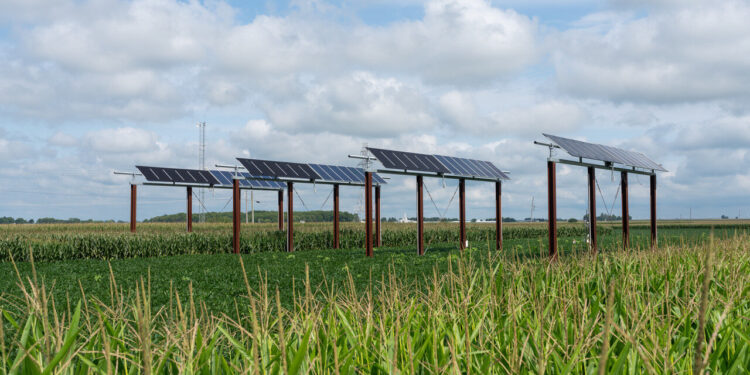The Purdue University Agricultural Research and Education Center’s experimental photovoltaic farm in soybean and corn fields. Credit: Purdue Agricultural Communications / Joshua Clark
A Purdue University research team has demonstrated how to optimize the yield of corn fields equipped with solar panels that cast dynamic shadows on the growing crops throughout the day.
The team of eight researchers from Purdue University and Aarhus University in Denmark published their findings on July 26, 2024 in Cell Reports on Sustainability.
Solar panels (photovoltaics) typically cast permanent shadows on the ground throughout the day. A permanent shadow on a farm field would be detrimental to crop growth. The Purdue team tested an agrivoltaic system that hangs over the crops to allow the combine to operate.
The system tracked the sun throughout the day. With constantly moving panels, each row of corn received different light intensities throughout the day, but none was placed in stable shade.
“We developed a model to calculate what fraction of light falls on each row,” said co-author Rakesh Agrawal, the Winthrop E. Stone Distinguished Professor of Chemical Engineering at Purdue.
Using the Purdue team’s models of plant growth and light intensity (dynamic shade), researchers can now ask crucial questions. What if the solar panels operated at a lower height? What if they were closer together or farther apart? What if they grew a shorter variety of corn?
“A season is a data point. If you want to change your variables, there’s only one summer a year, so if we change the height, you can only grow one crop that year to measure the impact,” Agrawal said. But with simulations, solar panel manufacturers, power companies and farmers can ask multiple hypothetical questions and quickly test multiple options.
The panels used in the Purdue experiment were 20 feet tall. But modeling has already shown that 10-foot-tall panels would produce similar results with much lower construction costs.
“We are showing the world that for corn, this can be done and it works very well,” Agrawal said.
Co-author Margaret Gitau, professor of agricultural and biological engineering, noted that in some situations, agrivoltaics can also affect the field’s microclimate in ways that promote crop climate resilience.
“Some areas may experience wetter and cooler conditions, while in others, conditions may not be any different than areas without solar panels,” Gitau said. “The shading provided by the panels may be important for retaining moisture in areas that experience water and heat stress during particularly dry periods.”
Agrivoltaics also offers the possibility of building self-contained water supply systems. Runoff or drainage water could be collected and recycled to provide supplemental irrigation using electricity generated on-site, she said.
Most agrivoltaic work in the United States focuses on specialty crops such as Brussels sprouts, raspberries, cabbages, and peppers. But these crops occupy a small percentage of land compared to row crops.
In 2022, corn, soybeans and wheat covered more than 200 million acres in the United States, according to the Food and Agriculture Organization of the United Nations.
“The opportunities at scale are enormous,” said Mitch Tuinstra, Wickersham Professor of Agricultural Research, even considering the specific needs of agrivoltaic systems, including nearby transmission lines, flat soil and moisture limitations.
The lead author of the interdisciplinary study, PhD student Varsha Gupta, is co-supervised by Agrawal and Gitau. “Varsha was able to integrate knowledge from various disciplines, including chemical engineering, data science, artificial intelligence, mathematics, and agricultural and biological engineering, which is no small feat,” Gitau said.
The new paper follows a related study published last March by six of the same co-authors that described how to optimize agrivoltaic systems for food or energy production by adjusting solar tracking or anti-tracking.
Continuous tracking generates the most energy. Anti-tracking casts no shadows on crops but also generates no electricity. The new study explains how to optimize the system through dynamic shadow modeling.
The experimental results published in both papers revealed a relatively small impact of dynamic shading on agrivoltaic corn yield. The data sets were somewhat different, but corn in both experiments was shaded 20 to 25 percent of the time.
“You would think there would be a 20 to 25 percent loss. We are seeing a loss of about 8 percent,” Tuinstra said.
Farmers can earn $1,000 per acre of electricity production if they optimize their production for energy, and about $300 per acre if they optimize their production for corn. Tuinstra imagines the day when a smart system connected to the Chicago Board of Trade could dynamically factor in corn and energy prices.
“The opportunities offered by agrivoltaics and renewable energy production can also contribute to future ecosystem services,” that is, the benefits that ecosystems provide to people, Tuinstra said. This becomes possible if new sustainable and regenerative agricultural technologies can be integrated with agrivoltaics.
Regenerative agriculture encompasses management strategies that include cover crops, grass strips, no-till farming, and minimal nitrogen fertilizer applications. These practices provide ecosystem services, but their costs are high for consumers, producers, and government.
“If you find a way to integrate these elements, all of a sudden you have ecosystem services funded by renewable energy. Everyone can benefit from these ecosystem services,” Tuinstra said.
More information:
Varsha Gupta et al., Optimization of agrivoltaic maize cultivation through farm-scale experimentation and modeling, Cell Reports on Sustainability (2024). DOI: 10.1016/j.crsus.2024.100148
Provided by Purdue University
Quote: Validated simulations optimize solar energy production through row-crop agriculture (2024, August 20) retrieved August 20, 2024 from
This document is subject to copyright. Apart from any fair dealing for the purpose of private study or research, no part may be reproduced without written permission. The content is provided for informational purposes only.



